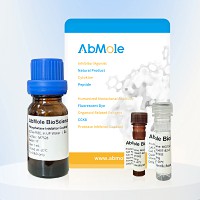All AbMole products are for research use only, cannot be used for human consumption.

Trypsin consists of a single chain polypeptide of 223 amino acid residues, produced by the removal of the N-terminal hexapeptide from trypsinogen which is cleaved at the Lys - lle peptide bond. The sequence of amino acids is cross-linked by 6 disulfide bridges. This is the native form of trypsin, beta-trypsin. BETA-trypsin can be autolyzed, cleaving at the Lys - Ser residue, to produce alpha-trypsin. Trypsin is a member of the serine protease family.
Trypsin cleaves peptides on the C-terminal side of lysine and arginine residues. The rate of hydrolysis of this reaction is slowed if an acidic residue is on either side of the cleavage site and hydrolysis is stopped if a proline residue is on the carboxyl side of the cleavage site. The optimal pH for trypsin activity is 7-9. Trypsin can also act to cleave ester and amide linkages of synthetic derivatives of amino acids. EDTA is added to trypsin solutions as a chelating agent that neutralizes calcium and magnesium ions that obscure the peptide bonds on which trypsin acts. Removing these ions increases the enzymatic activity.
Serine protease inhibitors, including DFP, TLCK, APMSF, AEBSEF, and aprotinin, amongst others, will inhibit Trypsin.
Application
For trypsin digestion of peptides, use a ratio of about 1:100 to 1:20 for trypsin:peptide. The typical use for this product is in removing adherent cells from a culture surface. The concentration of trypsin necessary to dislodge cells from their substrate is dependent primarily on the cell type and the age of the culture. Trypsins have also been used for the re-suspension of cells during cell culture, in proteomics research for digestion of proteins and in various in-gel digestions. Additional applications include assessing crystallization by membrane-based techniques and in a study to determine that protein folding rates and yields can be limited by the presence of kinetic traps.
Preparation Note
Soluble in 1 mM HCl at 1 mg/mL.
It is also TPCK-treated and dialyzed. Treatment with L-1-Tosylamide-2-phenylethyl chloromethyl ketone (TPCK) reduces the chymotrypsin activity which is usually present in trypsin.
Caution
Solutions in 1 mM HCl are stable for 1 year in aliquots and stored at -20°C. The presence of Ca2+ will also diminish the self-autolysis of trypsin and maintain its stability in solution. Trypsin will also retain most of its activity in 2.0 M urea, 2.0 M guanidine HCl, or 0.1% (w/v) SDS.
| CAS Number | 9002-07-7 |
| Form | Lyophilized powder |
| Solubility (25°C) | 1mM HCL: 1 mg/mL |
| Storage | -20°C |
| Related Enzymes & Coenzymes Products |
|---|
| β-Galactosidase (from Aspergillus oryzae)
β-Galactosidase acts on the terminal β-D-galactosyl moieties of disaccharides, glycoconjugates, and polysaccharides. It is useful in mediating transglycosylation reactions such as the synthesis of galactooligosaccharides (GOS). β-Galactosidases might be used for glycobiological and biotechnological applications. β-galactosidase cleaves lactose into its monosaccharide components, glucose and galactose. It also catalyses the transglycosylation of glucose into allolactose, the inducer of β-galactosidase, in a feedback loop. |
| Butyryl Cholinesterase (Horse serum)
Butyryl Cholinesterase is a serine hydrolase that is structurally similar to acetylcholinesterase (AChE) but has different substrate specificity and inhibitor sensitivity. The enzyme is a tetrameric glycoprotein composed of four identical subunits (110 kDa each) and is also known as pseudocholinesterase. It is synthesised in the liver and distributed in blood, neuromuscular junction synapses, glial cells and white matter axons. |
| β-Glucosidase (from Almonds)
β-Glucosidase is the main component of glycoside hydrolases that hydrolyse Glucoside into glucose and other constituents. β-Glucosidase works by breaking down fibre-rich cell walls to release and utilise the nutrients such as proteins and starch contained therein, while at the same time degrading the fibre to reducing sugars that can be digested and assimilated by the body of the animal. |
| Diaphorase
Diaphorase has been used in a study to assess the protein-protein interactions in assembly of lipoic acid on the 2-oxoacid dehydrogenases of aerobic metabolism. |
| Lipase (pocine pancreas)
Lipase is a class of enzymes with a variety of catalytic abilities that catalyse the hydrolysis of ester bonds at the lipid-water interface, and can catalyse the hydrolysis, alcoholysis, esterification, transesterification and reverse synthesis reactions of triacylglycerol esters and some other water-insoluble esters. Lipase can be used in biochemical research, analysis of prostaglandin esters and triglycerides in serum, and fat analysis. |
All AbMole products are for research use only, cannot be used for human consumption or veterinary use. We do not provide products or services to individuals. Please comply with the intended use and do not use AbMole products for any other purpose.


Products are for research use only. Not for human use. We do not sell to patients.
© Copyright 2010-2024 AbMole BioScience. All Rights Reserved.
